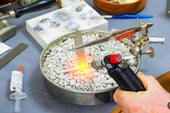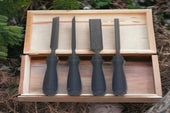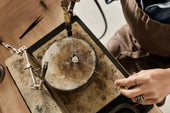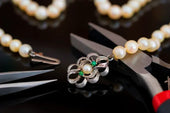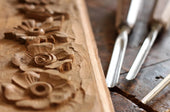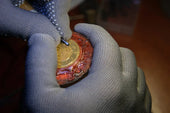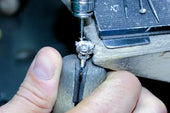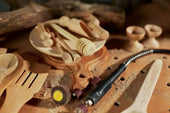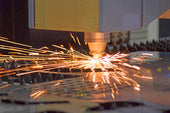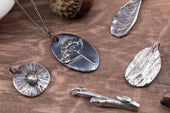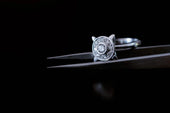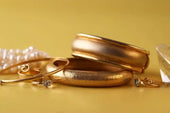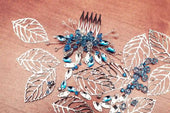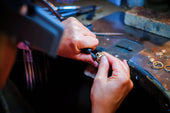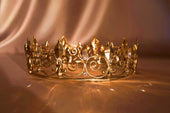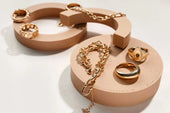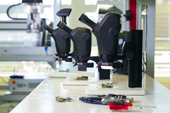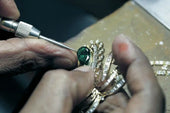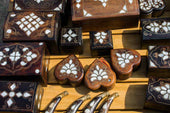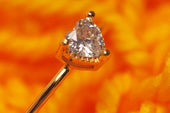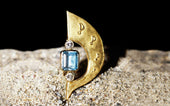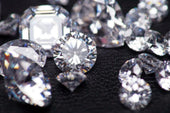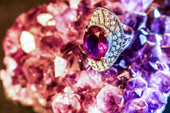The reason why a piece of jewelry is loved by people is not only that the sculptor shows his skillful jewelry carving on the jewelry piece, but also the sparkling variety of gemstones on the jewelry captivates people. The fact that the weight of a gemstone is labeled in carats is an indication of how small and lovely a gemstone can be. So, how does a small gemstone or even a smaller diamond get fixed on a piece of jewelry? Next, this blog will introduce you to gemstone setting techniques.
What is a stone setting?
Gemstone setting is the process of firmly fixing a gemstone into a piece of jewelry and involves both aesthetic design and gemstone protection. Different settings result in jewelry that not only showcases the brilliance of the gemstone, but also ensures that the wearer is comfortable and at ease in their daily life. Whether it's the nature of your work, your sporting habits, or your domestic activities, the right setting will make the jewelry both aesthetically pleasing and functional, avoiding any discomfort or damage caused by poor design.
Common Gemstone Setting Techniques
Below are a few of the most common gemstone setting techniques that most jewelry on the market will adopt.
1. Claw setting
Characteristics: 4 to 6 claws are forged on the metal band of the ring by means of an engraving tool, and these metal claws are used to hold the gemstone in place.
Advantages: It allows the stone to show off its charms to the fullest extent, and light can enter from all angles, enhancing the sparkle of the stone.
Cons: The metal claws may catch on clothing or hair, and the stone is more exposed and vulnerable to impact.
Application: Commonly used for setting diamonds and precious stones, is the most commonly used setting for gemstone rings.

2. Bezel Setting
Characteristics: Using a rolling machine to make a suitable metal edge with which to wrap around the gemstone to fix the gemstone.
Advantages: Protect the gemstone is not easy to fall off, suitable for daily wear.
Disadvantages: The display area of the gemstone is small, and light access is limited, which may affect the degree of sparkle.
Applicable: Suitable for all shapes of gemstones, especially larger ones, such as full diamond large pearl rings.

3. Channel setting
Characteristics: Gemstones are embedded in metal grooves with no metal separating them.
Advantages: Gemstones are closely arranged and the overall effect is smooth.
Disadvantages: the setting process is complex, requires the use of a stereo microscope, and is more difficult to maintain and clean.
Application: commonly used in the setting of small diamonds or gemstones, suitable for bracelets.
4. Pavé
Characteristics: many small gemstones are arranged closely together, and the metal is almost invisible on the surface.
Advantages: the overall effect is very sparkling, the gemstones cover a large area, the visual effect is very good.
Disadvantages: the setting process is complicated, the cost is high, and the small gemstones are easy to fall off.
Application: commonly used in the design of multi-layer bracelets and necklaces.

5. Invisible setting
Characteristics: there is no obvious metal border between the stones, it looks like the stones are directly connected together.
Advantages: the overall effect is very gorgeous, the surface of the gemstone looks continuous.
Disadvantages: the process is extremely difficult, test the skills of carvers, and repair and maintenance costs are high.
Application: Commonly used in high-end jewelry design, especially for rectangular stones.
6. Bead Setting
Characteristics: small metal beads are used to fix the gemstone to the metal surface.
Advantages: The stone is firmly fixed and the surface looks simple.
Disadvantage: the metal beads may wear out, affecting the aesthetics.
Application: Suitable for small gemstones, commonly found in tiny earrings.
7. Tension setting
Characteristics: The tension of the metal is used to hold the stone in place, making it appear as if the stone is suspended between the metals.
Advantages: modern design and excellent display of the gemstone.
Disadvantages: the gemstone rubs against the metal for a long time and wears out faster.
Application: Often used in modern style jewelry design.
8. Clip-on
Characteristics: Uses a metal bar to hold the gemstone in place, usually used for rectangular or square stones.
Advantages: Unique look, gemstones can show beautiful light from the bottom, top, and sides without obstruction.
Disadvantage: The sides of the stone are more exposed and prone to wear and tear.
Suitable: For flexible metals, and round or oval stones with a high Mohs hardness.
Gemstone Setting Precautions
Regardless of the gemstone setting technique, there are similar issues to be aware of during the actual execution:
Secure the jewelry: most jewelry is delicate and small, and requires the use of specialized tools, such as a ball vise, to prevent the jewelry from moving.
Patience: Patience is essential when performing delicate operations in the setting to prevent the stone from loosening or falling out due to carelessness.
Sharpen your tools: Before starting the setting, remember to sharpen the cutter of your pneumatic engraving machine to improve the efficiency of the setting.
Conclusion
There are many ways to set gemstones, each of which has its own unique beauty and applicable scenarios. Choosing the right setting can better showcase the charm of the gemstone while ensuring that it is secure and comfortable to wear. This blog not only helps you to understand the gemstone setting techniques, but also provides you with reference suggestions for purchasing jewelry.


